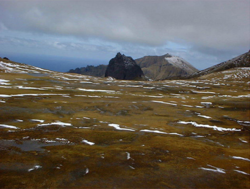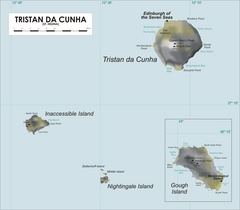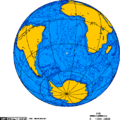Gough Island
| Gough Island | |

| |
|---|---|
| Location | |
| Location: | 40°2’60"S, 9°57’-0"W |
| Data | |
Gough Island, also known historically as Gonçalo Álvares (after the Portuguese explorer) or as Diego Alvarez, is a volcanic island in the South Atlantic Ocean. It is a dependency of Tristan da Cunha and part of the British overseas territory of St Helena, Ascension and Tristan da Cunha. Gough Island is uninhabited except for the personnel of a weather station (usually six people) which the South African National Antarctic Programme has maintained continually on the island since 1956. It is one of the most remote places with a constant human presence.
Name
The island was first named Ilha de Gonçalo Álvares on Portuguese maps (Spanish Isla de Gonzalo Álvarez). It was named Gough Island after Captain Charles Gough of the Richmond who sighted the island in 1713. Confusion of the unusual Portuguese name Gonçalo with Spanish Diego led to the name "Diego Alvarez island" in British sources from 1800s to 1930s.[1][2][3]
Geography and geology
Gough Island is roughly rectangular with a length of 8 miles and a width of 4 miles. It has an area of 35 square miles and rises to heights of over 2,900 feet above sea level.[4] The highest Peak is Edinburgh Peak. Other notable features of the landscape are Hags Tooth, Mount Rowett, Sea Elephant Bay, Quest Bay, and Hawkins Bay.
Gough Island has small satellite islands and rocks such as Southwest Island, Saddle Island (South), Tristiana Rock, Isolda Rock (West), Round Island, Cone Island, Lot's Wife, Church Rock (North), Penguin Island (Northeast), and The Admirals (East).
This is a remote, rugged and lonely place, about 250 miles southeast of the other islands in the Tristan da Cunha group, and 1,680 miles from Cape Town.
History
The details of the discovery of Gough Island are unclear, but the most likely occasion is July 1505 by the Portuguese explorer Gonçalo Álvares.[5] Maps during the next three centuries named the island after him. On some later maps, this was erroneously given as Diego Alvarez.
According to some historians, the British merchant Anthony de la Roché was the first to land on the island, in Spring 1675.[6]
Charles Gough rediscovered the island in March 1731, thinking it was a new find. It has since been named for him.
It was named Gonçalo Alvarez, after the captain of Vasco da Gama's flagship on his epic voyage to the east, and under this name it was marked with reasonable accuracy on the charts of the South Atlantic during the following 250 years. Then, in 1731, Captain Gough of the British ship Richmond reported the discovery of a new island, which he placed 400 miles to the east of Goncalo Alvarez. Fifty years later cartographers realized that the two islands were the same and despite the priority of the Portuguese discovery, and the greater accuracy of the position given by them, "Gough's Island" was the name adopted. [7]
In the early 19th Century, sealers sometimes briefly inhabited the island. The earliest known example is a sealing gang from the US ship Amethyst which remained on the island in 1806-1807.
Gough Island was claimed only in 1938, for Britain, during a visit by HMS Milford of the Royal Navy.
Wildlife
Gough and Inaccessible Island are a protected wildlife reserve, which has been designated a World Heritage Site by UNESCO. It has been described as one of the least disrupted ecosystems of its kind and one of the best shelters for nesting seabirds in the Atlantic. In particular, it is host to almost the entire world population of the Tristan Albatross (Diomedea dabbenena) and the Atlantic Petrel (Pterodroma incerta).[8] However, this status is now in doubt as in April 2007 researchers published evidence that predation by introduced house mice on seabird chicks is occurring at levels that might drive the Tristan Albatross and the Atlantic Petrel to extinction.[9] The island is also home to the almost flightless Gough Island Moorhen, and the critically endangered Gough Bunting.
The Royal Society for the Protection of Birds has since been awarded £62,000 by the UK government's Overseas Territories Environment Programme to fund additional research on the Gough Island mice and a feasibility study of how best to deal with them. The grant will also pay for the assessment of a rat problem on Tristan da Cunha island.
Important Bird Area
The island has been identified as an Important Bird Area (IBA) by BirdLife International for its endemic landbirds and as a breeding site for seabirds. Birds for which the IBA has conservation significance include Northern Rockhopper Penguins (144,000 breeding pairs), Tristan Albatrosses (1000-1500 pairs), Sooty Albatrosses (5000 pairs), Atlantic Yellow-nosed Albatrosses (5000 pairs), Broad-billed Prions (100,000 pairs), Kerguelen Petrels (20,000 pairs), Soft-plumaged Petrels (50,000 pairs), Atlantic Petrels (20,000 pairs), Great-winged Petrels (5000 pairs), Grey Petrels (10,000 pairs), Great Shearwaters (100,000 pairs), Little Shearwaters (10,000 pairs), Grey-backed Storm Petrels (10,000 pairs), White-faced Storm Petrels (10,000 pairs), White-bellied Storm Petrels (10,000 pairs), Antarctic Terns (500 pairs), Southern Skuas (500 pairs), Gough Moorhens (2500 pairs) and Gough Buntings (3,000 individuals).[10]
Weather station
The weather station on Gough Island is operated as part of the network of the South African Weather Service. Because cold fronts approach South Africa from the south-west, the Gough station is particularly important in forecasting winter weather.
Maps
-
Relief map
-
Orthographic projection
-
Satellite map
Outside links
- The South African Weather Station on Gough Island - Official website.
- Wiki site for Southern Ocean Islands and Antarctica
- Gough Island on GlobalGuide
- Map of Gough Island, with PDF downloadable
- The South Atlantic and Subantarctic Islands: Gough Island
- UNESCO Gough & Inaccessible Islands Wildlife Reserve
- Photographs by one of the South African Weather Station staff who was based on Gough Island.
References
- ↑ Report on the geological collections made during the voyage of the ... British Museum (Natural History), Walter Campbell Smith, British Museum (Natural History) - 1930 "DIEGO ALVAREZ OR GOUGH ISLAND. By W. Campbell Smith. Gough Island, as it seems to be more usually called, lies about 200 miles south of the Tristan da Cunha group in latitude 40° S., longitude 10° W.1 It is about 8 miles long by 3 ..."
- ↑ Plants of Gough Island: (Diego Alvarez) Erling Christophersen - 1934
- ↑ The Antarctic dictionary: a complete guide to Antarctic English - Page 150 Bernadette Hince - 2000 -"I went for adventure. to have fun, Gough Island Gough Island was named I. de Goncalo Alvarez on early maps. after its discoverer. Portuguese navigator Goncalo Alvarez. The name was later corrupted to I. Diego Alvarez. and there was confusion about the locality. It was renamed after Captain Charles Gough of the British barque Richmond. who sighted the island in 1713."
- ↑ "Gough Island". Sanap.ac.za. http://www.sanap.ac.za/sanap_gough/sanap_gough.html. Retrieved 2012-10-25.
- ↑ "South African Journal of Science - Gough Island 500 years after its discovery: a bibliography of scientific and popular literature 1505 to 2005". Scielo.org.za. http://www.scielo.org.za/scielo.php?pid=S0038-23532008000500005&script=sci_arttext. Retrieved 2012-10-25.
- ↑ Wace N.M. (1969). "The discovery, exploitation and settlement of the Tristan da Cunha Islands". Proceedings of the Royal Geographical Society of Australasia (South Australian Branch) 10: 11–40.
- ↑ Heaney, J.B., Holdgate, M.W. (1957). The Gough Island Scientific Survey.The Geographical Journal, Vol. 123, No. 1, pp. 20-31
- ↑ Cuthbert, J. & Sommer, E. Population size and trends of four globally threatened seabirds at Gough Island, South Atlantic Ocean. Marine Ornithology 32: 97–103.
- ↑ R M Wanless, A Angel, R J Cuthbert, G M Hilton and P G Ryan (2007). "Can predation by invasive mice drive seabird extinctions?". Biology Letters 3 (3): 241–244. doi:10.1098/rsbl.2007.0120. PMID 17412667.
- ↑ "Gough Island". Important Bird Areas factsheet. BirdLife International. 2012. http://www.birdlife.org. Retrieved 2012-10-25.
| World Heritage Sites in the British Overseas Territories |
|---|
|
Gough Island and Inaccessible Island, Tristan da Cunha • Henderson Island (Pitcairn Islands) • Town of St George and Related Fortifications |



